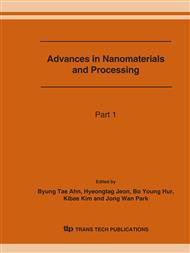p.1653
p.1657
p.1661
p.1665
p.1669
p.1673
p.1677
p.1681
p.1685
Analysis on the Martensitic Transformation in the Ti-xNb Alloys Using a Phenomenological Theory
Abstract:
The titanium alloys containing the Nb transition elements have been investigated as the Ni-free shape memory and the biomedical alloys with a low elastic modulus. The mechanical properties of the alloys depended upon the meta-stable phases like the α`, α``, ω. To study the martensitic transformations from the β to α`` or α` the Ti-xNb (x=0 to 40 wt%) alloys were melted into the button type ingots using a VAR, and followed by the water-quenching after the soaking at 1000oC for 2hrs. The crystallography of the martensitic phases in the water-quenched alloys was analyzed using a XRD. The diffraction peaks of the orthorhombic martensites were identified by the crystallographic relationship with the bcc matrix. The lattice parameters of the orthorhombic martensites were varied continuously with the contents of the Nb elements. The martensitic transformations of the alloys were studied using the phenomenological theory of Bowles and Mackenzie.
Info:
Periodical:
Pages:
1669-1672
Citation:
Online since:
June 2007
Authors:
Price:
Сopyright:
© 2007 Trans Tech Publications Ltd. All Rights Reserved
Share:
Citation:


